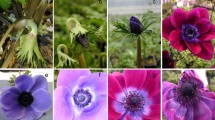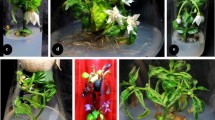Abstract
To determine the viability of hot water emasculation for Acacia auriculiformis, spikes composed of about 100 flowers were soaked in hot water at varying temperatures (45–60°C) and for varying lengths of time (5 s to 7 min) prior to anthesis. The rate of squashed polyads, each of which consisted of 16 pollen grains, and the germinating rate on media, decreased with temperature and time. A mating test suggested that the rates of adhering polyads per stigma and germinating polyads per stigma were lower in the self-pollination of soaked spikes than in that of normal spikes. On the other hand, the number of matured pods was not significantly different in the mating between the spikes receiving the soaking treatment (♀) and the spikes receiving no treatment (♂) compared with the mating between normal spikes. Although further research is needed to determine the optimal treatment conditions, these results suggest that soaking spikes into hot water, especially at 50°C for 45 s, 54°C for 15 s, and 56°C for 10 s, is an effective emasculation technique.




Similar content being viewed by others
References
Bajaj M, Cresti M, Shivanna KR (1991) Effects of high temperature and humidity stresses on tobacco pollen and their progeny. In: Ottaviano E, Mulcahy DL, Sari-Gorla M, Mulcahy GB (eds) Angiosperm pollen and ovule. Springer, New York, pp 349–354
Dumas C, Knox RB, Gaude T (1984) Pollen-pistil recognition: new concepts from electron microscopy and cytochemistry. Int Rev Cytol 90:239–272
Eschobin RP, Payawal PC, Cervancia CR (2004) Pollination syndrome and breeding system of four reforestation tree species in Mt. Makiling, Luzon, Philippines. Philipp Agric Sci 87:182–190
Ford HA, Forde N (1976) Birds as possible pollinators of Acacia pycnantha. Aust J Bot 24:793–795
Ibrahim Z (1991) Reproductive biology of Acacia mangium Willd. and A. auriculiformis A. Cunn. ex Benth. PhD thesis, Universiti Pertanian Malaysia
Ibrahim Z, Awang K (1992) Comparison of floral morphology, flower production and pollen yield of Acacia mangium and A. auriculiformis. ACIAR proceedings no. 37 (Breeding technologies for tropical Acacias):26–29
Kenrick J, Knox RB (1982) Function of the polyad in reproduction of Acacia. Ann Bot 50:721–727
Kenrick J, Knox RB (1985) Self-incompatibility in the nitrogen-fixing tree, Acacia retinoides: quantitative cytology of pollen tube growth. Theor Appl Genet 69:481–488
Kha LD (1996) Studies on natural hybrids of Acacia mangium and A. auriculiformis in Vietnam. In: Dieters MJ, Matheson AC, Nukles DG, Harwood CE Walker SM (eds) Tree improvement for sustainable tropical forestry. QFRI-IUFRO Conference, Caloundra, Queensland, Australia 27 Oct–1 Nov, 1996, vol 2, pp 328–332
Kinjo K (1989) Method of emasculation of sugarcane flower by hot-water treatment in sugarcane breeding. Bull Okinawa Agric Exp Sta 13:1–12
Knox RB, Kenrick J, Jobson S, Dumas C (1989) Reproductive function in the memosoid legume Acacia retinode: ultrastructural and cytochemical characteristics of stigma receptivity. Aust J Bot 37:103–124
Kondo Y (1939) Artificial crossing of Oryza sativa using hot water emasculation. Nogyo Oyobi Engei 14:41–52
Martin FW (1959) Staining and observing pollen tubes in the style by means of fluorescence. Stain Technol 34:125
MTIB (2007) Eight selected species for forest plantation programme in Malaysia. Malaysian Timber Industry Board, Kuala Lumpur, Malaya
Mukasa Y, Suzuki T, Honda Y (2006) Emasculation of self-pollinating buckwheat using hot water. Jpn Soc Breed 8:177–181
Nagata Y, Yoshida M (1997) Fundamentals of statistical multiple comparison methods. Science, Tokyo
Nandini R, Fakrudin B (1999) Emasculation in finger millet using hot water. J Agric Sci 33:6–10
Ngamkhajornviwat S, Luangviriyasaeng T (1991) Floral development of Acacia auriculiformis. In: Turnbull JW (ed) Advances in tropical Acacia research. Canberra: Aust Cent Internat Agr Res 35:30–31
Ogawa Y, Otsuka J, Yamaguchi S, Chigira O (2008) The most favorable time for controlled pollination in Acacia auriculiformis A. cunn. ex Benth. Jpn For Soc Cong 119:139
Pedley L (1978) A revision of Acacia Mill in Queensland. Austrobaileya 1:75–234
Sedgley M (1981) Ultrastructure and histochemistry of the watermelon stigma. J Cell Sci 48:137–146
Sedgley M, Harbard J, Smith RM, Wickneswari R (1992a) Development of hybridization techniques for Acacia mangium and Acacia auriculiformis. In Carron LT, Aken KM (eds) Breeding technologies for tropical acacias. Aust Cent Int Agric Res 37:51–56
Sedgley M, Harbard J, Smith RM, Wickneswari R, Griffin AR (1992b) Reproductive biology and interspecific hybridization of Acacia mangium and Acacia auriculiformis A. Cunn.ex Benth. (Leguminoae: Mimosoideae). Aust J Bot 40:37–48
Shivanna KR, Linskens HF, Cresti M (1991) Responses of tobacco pollen to high humidity and heat stress: germination in vitro and vivo. Sex Plant Reprod 4:104–109
Siegel S, Castellan NJJ (1988) Nonparametric statistics for the behavioral sciences, 2nd edn. McGraw-Hill, New York
Sornsathapornkul P, Tangmitcharoen S (1992) The initiation and development of brown salwood (Acacia mangium Willd.) flower. Thai J For 11:22–23
Stone GN, Raine NE, Prescott M, Willmer PG (2003) Pollination ecology of acacias (Fabaceae, Mimosoideae). Aust Syst Bot 16:103–118
Tang KC (1962) A study on emasculation of sugarcane by use of hot water treatment. Rept TSES 26:11–161
Tham CK (1976) Introduction to plantation species Acacia mangium Willd. Proceedings of the 6th Malaysian forestry conference, Kuching, Sarawak, Malaysia, pp 153–158
Wickneswari R, Bell JC, Moran GF, Griffin AR (1989) Validity of controlled crosses between Acacia mangium and Acacia auriculiformis. Proceedings of plantation forestry conference, Kuala Lumpur
Yamaguchi S, Ogawa Y (2009) Discussion of germination test and storage method in relation to pollens of Acacia auriculiformis. Special issue of Tree Breed (in press)
Acknowledgments
The authors would like to thank the Forestry and Forest Products Research Institute, and especially Dr. R. Nakata for his invaluable comments on this manuscript.
Author information
Authors and Affiliations
Corresponding author
About this article
Cite this article
Otsuka, J., Yamaguchi, S., Chigira, O. et al. Application of hot water emasculation to Acacia auriculiformis for controlled pollination. J For Res 15, 210–216 (2010). https://doi.org/10.1007/s10310-009-0174-0
Received:
Accepted:
Published:
Issue Date:
DOI: https://doi.org/10.1007/s10310-009-0174-0




